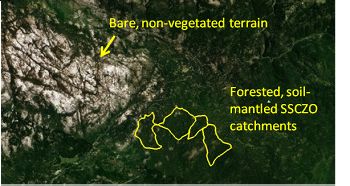Lithologic Control on Productivity & Landscape; Hahm
PRESENTATION/TALK | EDUCATION/OUTREACH
Strong Lithologic Control on Mountain Ecosystem Productivity and Landscape Evolution
CCC Mile High Ballroom 2C
Session No. 165
T18. Critical Zone Evolution: Climate and Exhumation
Monday, 28 October 2013: 1:00 PM-5:00 PM
Colorado Convention Center Mile High Ballroom 2C
Geological Society of America Abstracts with Programs. Vol. 45, No. 7, p.408
See overview of SSCZO activity at GSA 2013. Abstract in the GSA meeting program.
HAHM, W. Jesse, RIEBE, Clifford S., LUKENS, Claire E., and ARAKI, Sayaka, Geology and Geophysics, University of Wyoming, 1000 E University Ave, Laramie, WY 82071, whahm@uwyo.edu
Mountain landscapes provide sharp altitudinal gradients in environmental conditions over short distances that are often uninterrupted by large differences in lithology. For this reason, they are commonly used as natural laboratories for understanding erosion, weathering, pedogenesis and ecosystem processes. In particular, granitic terrain, common in many mountain ranges, is widely used to study climatic effects on surface processes, because it is thought to be homogeneous compared to other lithologies found at Earth’s surface. Here we show that geochemical differences among plutons correspond with sharp contrasts in weathering, erosion, and ecosystem productivity along a 180 km transect through non-glaciated portions of the Sierra Nevada Batholith, California. We couple bedrock geochemistry with tree cores and remotely-sensed canopy cover to show that productivity varies systematically with the underlying substrate when climate and topography are held constant. Pluton contacts coincide over tens of kilometers with abrupt ecotones between dense mixed-conifer forests and exposed bedrock. Our catchment-wide measurements of 10Be indicate that soil-mantled, forested areas erode ~2.5 times faster than predominantly exposed-bedrock areas, indicative of a feedback between bedrock, vegetation, weathering and erosion. Canopy cover and bedrock phosphorus concentration covary across more than an order of magnitude. We propose that this reflects a parent-material-driven nutrient limitation, where ecosystem productivity appears to be controlled by an element present on average at only 600 ppm in bedrock. The 21 sites in our lithosequence span nearly the full geochemical range of Cordilleran granitoids, implying that hitherto undetected lithologic control on ecosystem productivity and landscape evolution may be widespread in mountain ranges.
In the Sierra Nevada, exposed outcroppings and bare peaks abut dense forests. Why?
Related Events
Explore Further

